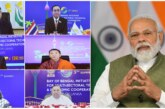In the aftermath of recent visit of Russian President Dmitry Medvedev to India, the pattern of bilateral relationship between New Delhi and Moscow has witnessed an upsurge. The visit proved instrumental in concluding deals to cooperate on nuclear energy, trade and pharmaceuticals. In the joint statement issued after Russian President’s visit, India’s Prime minister Dr Manmohan Singh called Russia a “time-tested friend of India,” and Medvedev reiterated support for India to gain a permanent seat on the United Nations Security Council.
Describing Moscow as a “major energy power”, the Russian President while talking to media persons in New Delhi, stressed Russia’s role as a key energy supplier and an uncompromising stand on terror to single out his visit from the overtures of others. Among 15 agreements, he signed a pact to align India’s oil and gas companies with powerful Russian state-owned energy companies, like Gazprom, and an agreement to supply two nuclear reactors.
While heavily promoted the complementary nature of his economy to India President Medvedev pushed for a “modern” engagement across sectors including pharmaceuticals, defence and space technology. He also added: “I believe that trade between us does not nearly reflect our privileged partnership. India is a comfortable partner especially in energy.”1
Arms Deal
During the course of recent visit of Russian President to India, President Medvedev signed a contract for the joint development of a new fighter aircraft during a visit to India. The deal could eventually be worth $30bn to Russia. It is worth recalling here that India’s defence acquisitions were primarily from erstwhile Soviet Union and latter used to meet India’s defence requirements, including agreements for joint production of some weapon systems.
The post-Soviet Russia was embroiled in internal troubles during the decade of the 1990s and there arose some hiccups on supply of spare parts. India’s improving relations with the US and other Western countries opened up new avavues for India for meeting its defence requirements.
The past decade has seen India diversifying its weapons suppliers and, despite the new contract, Russia faces stiff competition for Indian arms contracts from Europe and the US. Recognising this in an interview in the Times of India on the eve of his visit to India, President Medvedev said: “There is a reason that Western manufacturers of arms and military equipment are also interested in co-operating with India. We accept this calmly and pragmatically. We are ready to compete. But it’s important that all contracts are transparent and follow the rules.”2
According to some experts, Russian President’s ‘calmness’ is underpinned by the historic ties between New Delhi and Moscow. According to Viktor Mizin, of the Moscow State Institute for International Relations, the pattern of India’s relationship with Erstwhile Soviet Union during the Cold War was originally based on mutual geopolitical interests. When the former Soviet Union had problems with China, then India would balance China because India had also an uneasy relationship with China.
An embargo on the supply of Indian nuclear materials in the wake of India’s conducting nuclear capable tests in May 1998 provided the relationship extra stimulus, and indirectly influenced the trade in arms. In the opinion of Alexander Goltz, deputy editor of the online newspaper Daily Journal, initially Russia had no competitors. India needed relatively up-to-date military hardware, and only Russia could supply it. However, the situation transformed in the post-Cold War period and when Western suitors appeared in India’s arms market, the weaknesses in Russia’s defence industry came to the fore.
Russia has entered the new competitive market as arms supplier with a mixed bag of success and failure. Indo-Russian co-operation hit a low over the contract to upgrade the Admiral Gorshkov, an aircraft carrier bought by India and left for modernisation in Russia. Under the Indian flag, the carrier will be called Vikramaditya. According to the original contract signed in 2004, the repairs were to cost half a billion dollars, but later rose to $2.3bn.
As the situation obtains at presently, delivery dates have been put back by almost a year until the end of 2012. In India, many have started to doubt the merits of the deal, but cancelling is out of the question, bearing in mind the big sums already invested. Experts have also highlighted problems with other contracts, in particular with after-sales service and spare parts.
According to one opinion, India wants to reassess its arms-buying process so as to include delivery and service in a single package. “It would be easier for us to sign a single contract for the lifetime of a weapon such as a tank, so that its service and everything else is included in the price.”3
While still buying Russian tanks and aircraft, India continues to actively seek an alternative to Russian weapons. India is likely to purchase C-17 and C-130 transport planes from the US. An ongoing process to bid for the supply of 126 fighter jets to the Indian Air Force ends in 2011. As well as Russian MiG-35s, American F-16 and F-18s, the Eurofighter and the Swedish Gripen are also tendering for the contract.
In the wake of India diversifying its arms procurement options, Moscow may be faced with a serious challenge, but does not intend give up its position in the market. President Medvedev’s signing of the new fifth-generation fighter plane contract is evidence to this. Talks over the aircraft have been going on since 2005. Initially, Russia hoped to sign a contract to deliver its T-50 fighter plane to India, but in the end India insisted on the joint development of a new aircraft, based on the T-50 but with modifications for the Indian Air Force.
Ilya Kramnik, military analyst for the RIA Novosti news agency, has opined that a jointly developed aircraft will differ significantly from the Russian T-50. According to him,”India wants it to have a twin-seat cockpit and wants the plane to be much more versatile. India needs the plane to be able to cope with dogfights and strike missions and this all complicates the project.”4
It is noteworthy that Russia still has other contracts with India, in particular the modernisation of weapons already delivered. By the best estimates, 80% of India’s army is equipped with Russian hardware. Experts are confident that more arms deals will be signed in the future, but when it comes to the supply of new weapons, specialists believe that the onus will be on joint development.5
Economic Ties
During the course of President Medvedev’s visit to India, it was also agreed to boost economic and trade ties between Moscow and New Delhi. Aiming to elevate their economic engagement to “strategic” levels, India and Russia agreed on 21 December 2010 to consider a free trade and investment agreement and push bilateral commerce to USD 20 billion in five years.
A joint statement issued in New Delhi the same day said the two sides “agreed to continue their efforts to achieve the strategic target of bilateral trade volume of USD 20 billion by 2015… Both sides agreed to consider the possibility of a Comprehensive Economic Cooperation Agreement (CECA) taking into account the implementation of the agreements on constituting the customs union between Russia, Kazakhastan and Belarus…”6
CECA, commonly described as free trade agreement (FTA), encompasses opening of trade through elimination or reduction of duties and removal of barriers in mutual investment. In the midst of the summit talks, top Indian companies, including Tata Sons, Reliance Industries, Dr Reddy”s Laboratories and ONGC Videsh signed 30 agreements with their Russian counterparts. Bilateral trade between India and Russia in 2009-10 stood at USD 4.54 billion and the two sides aspire to step it up more than four-fold in the next five years.
India is in the process of dismantling duty barrires through trade pacts with several countries and blocs like Japan, Malaysia, Thailand and European Union. Such pacts are already under implmentation with ASEAN, Singapore and South Korea. Russia, as a major energy producing country and India as a big consumer, viewed energy cooperation “as an important pillar of the strategic partnership.”
They also reviewed the ongoing efforts to establish joint cooperation ventures between Indian and Russian companies in the oil and gas sector. It was agreed that the inter-governmental agreement on cooperation in the hydrocarbon sector signed during the Summit, must serve as a legal mechanism. This is to expedite governmental clearances on both sides to facilitate the creation and operation of joint ventures.
They would promote specific projects including upstream and downstream activities in India, Russia and third countries. The two leaders noted that the conclusion of the agreement on simplification of visa procedures would help enhance contacts between the business communities of the two countries.7
Conclusion
There has been an upsurge in India-Russia relations in recent years and in the wake of recent highest level exchange of visits between the two countries, the prospects of furthe consolidation of relations have enhanced. However, more needs to be done by both sides to bring this relationship on a higher platform so that the past warmth gets revived. However, Russia’s immediate priorities in its neighbourhood and in Europe as well as India’s priorities in the region don’t converge but efforts should be continued towards consolidation.
Notes
-
- James Lamont, “Medvedev joins scramble for India’s business”, Financial Times (London), 21 December 2010, available at http://www.ft.com/cms/s/0/b02c3dc2-0d25-11e0-82ff-00144feabdc0.html .
- Cited in Pavel Aksenov, “India-Russia arms deal backed by historic ties”, BBC Russian Service, 21 December 2010, at http://bbc.co.uk/news/world-europe-12053004.
- Ibid
- Ibid
- Ibid
- PTI, “India, Russia to take economic ties to new ‘strategic’ high”, 22 December 2010, Economic Times, 23 December 2010.
- Ibid
By Dr. Arvind Kumar



